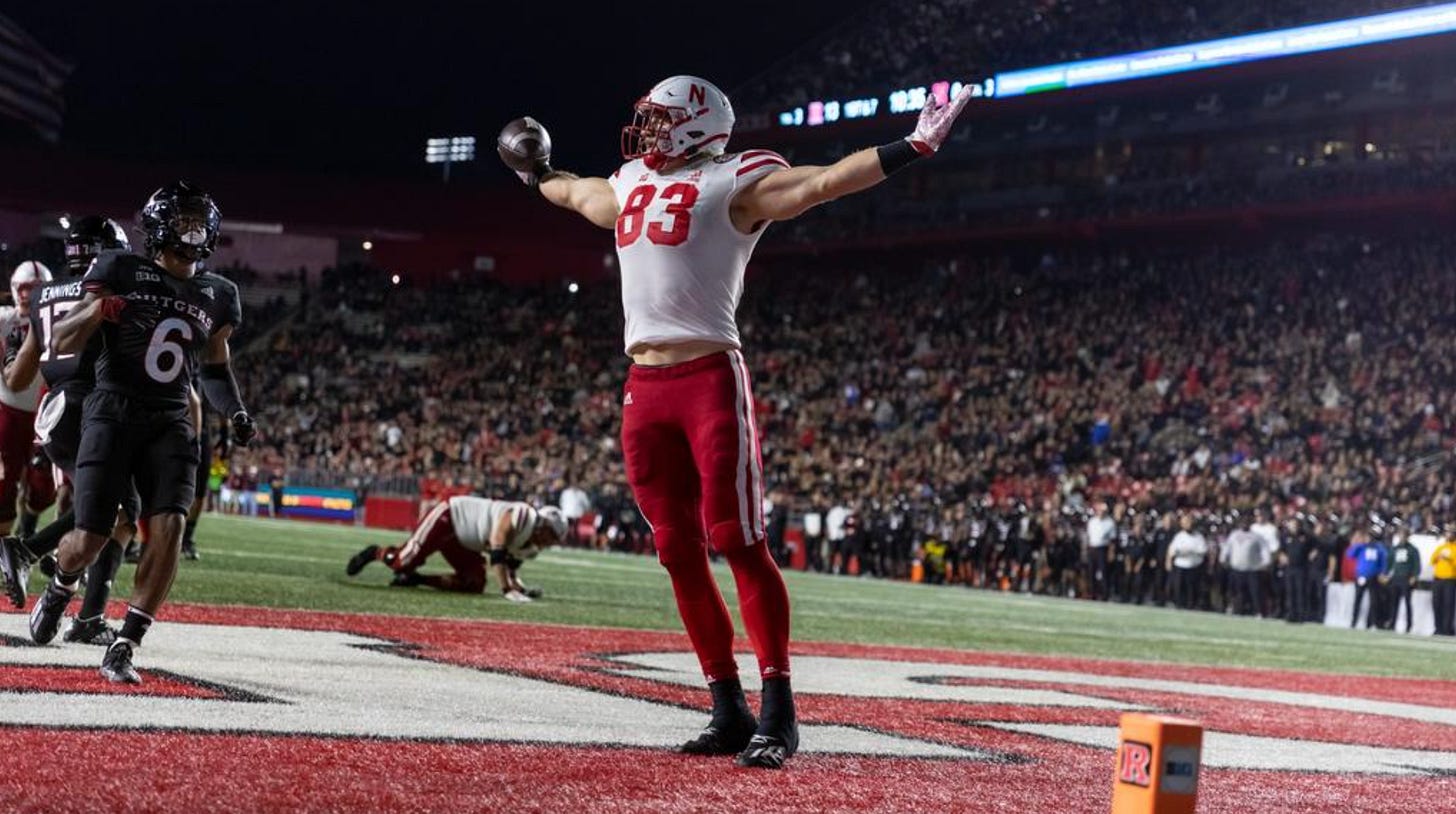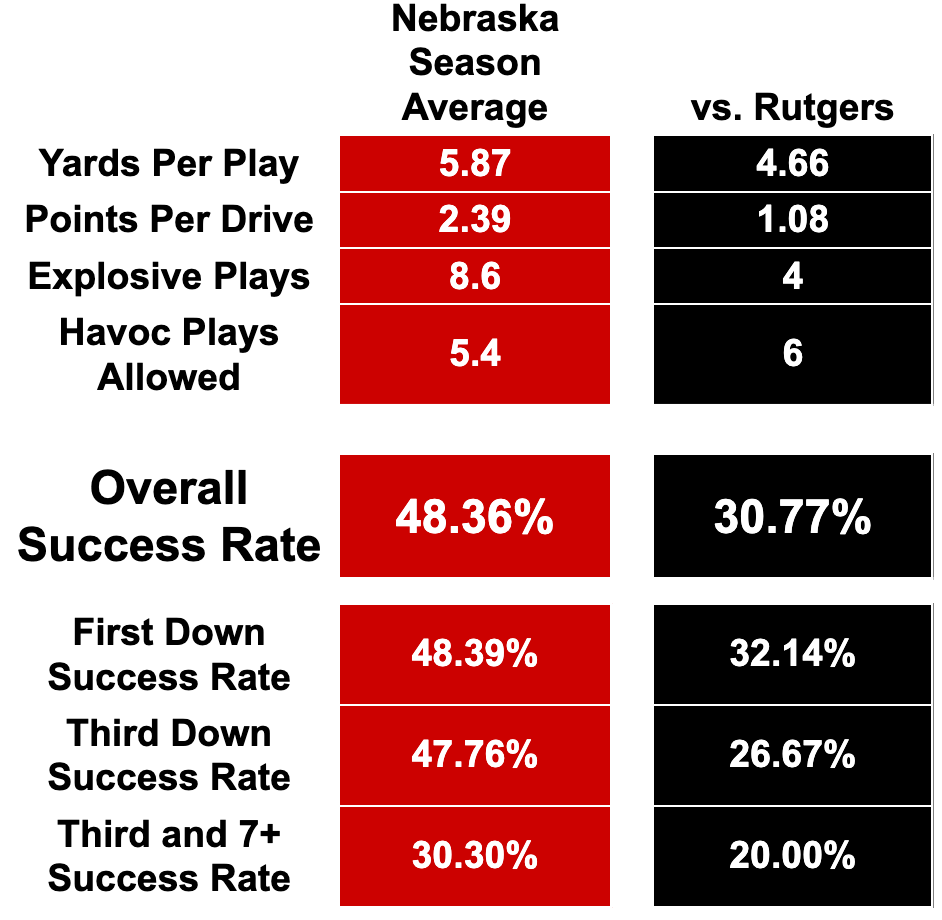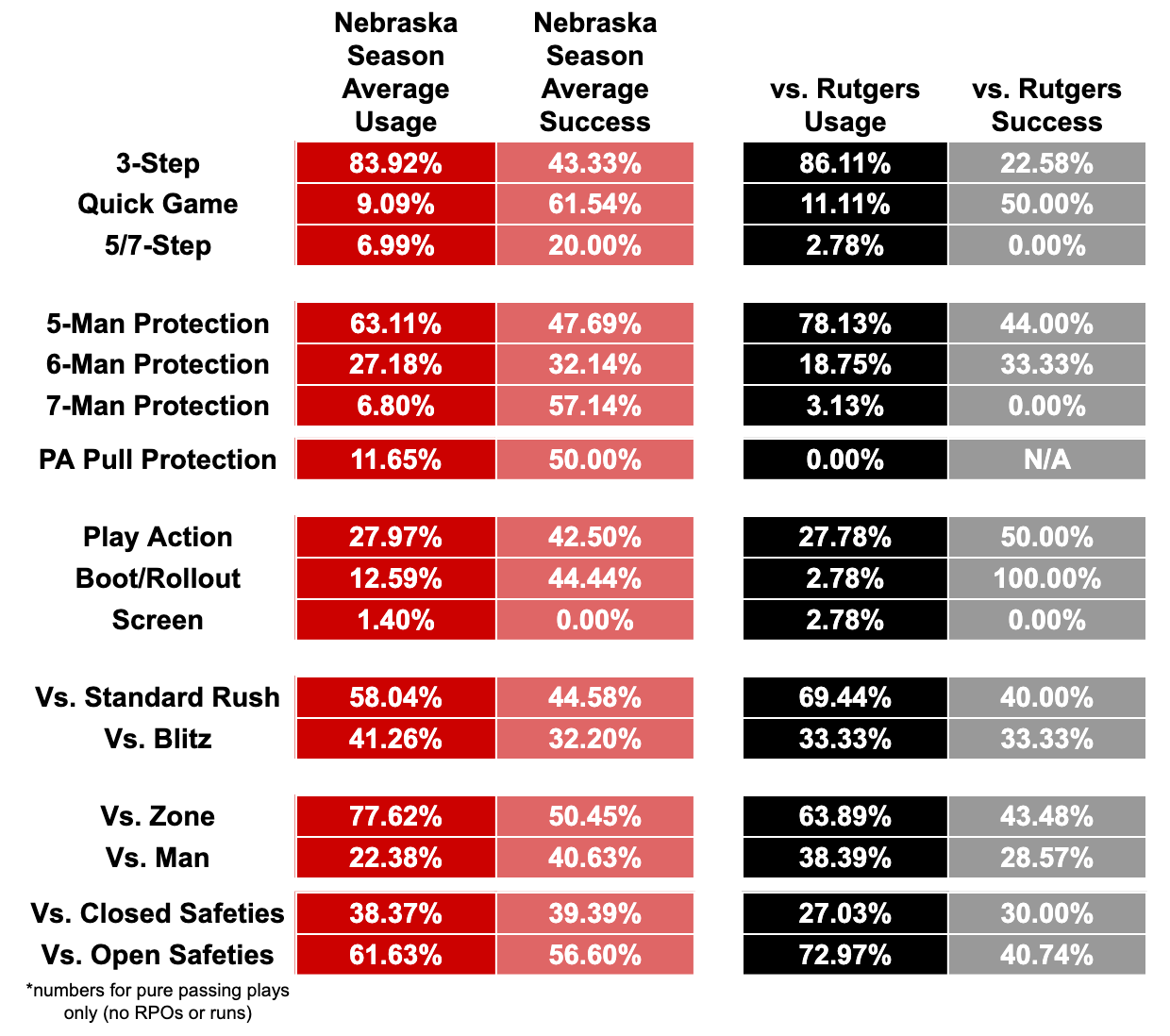RUTGERS RECAP: Freaky Friday
Nebraska has transformed from a mediocre team that couldn't win any games to a bad team that keeps stumbling into victories
LET’S HEAR IT FOR YOUR TIED FOR FIRST PLACE IN THE BIG TEN WEST NEBRASKA CORNHUSKERS:
Should you look at the quality of the two teams NU has beaten? No. Should you look at the quality of the teams on the upcoming schedule? Also no. Let’s all just enjoy this moment.
If you’re here for some real talk and analysis instead of jokes: This team has been bad. NU is currently 67th in SP+ after playing the easy games of its schedule and is surely on pace to have its worse overall team finish since the final year of the Mike Riley tenure — if not worse. After being a mediocre team (by the numbers) that could never actually win games for the first four years of Scott Frost’s tenure, NU is now just a bad team that keeps stumbling into victories in his posthumous one. While I’d love to hope the good luck holds and interim coach Mickey Joseph is able to take the reins of the job, the offense continues to turtle at an alarming rate now that it’s facing real competition, and the things that have led to the defensive improvement are due to start getting majorly burned any moment now. While I love the fight the team has shown under Joseph — he should get heaps of credit for keeping the team from imploding when down 13 points at halftime — Nebraska has not played like a real West contender and won’t be one without both sides of the ball getting a lot better very quickly.
PROGRAMMING NOTE: If you’re a new subscriber, I would suggest reading the post detailing the newsletter’s plan for this year; it will better explain things like success rate and what the numbers are trying to accomplish.
OFFENSE
GAME CHART
2022 Rutgers Offensive Game Chart
OVERALL
This was the offense’s worst performance of the season so far by just about every metric, even worse than the Oklahoma game. Rutgers does have a good defense — it was ranked 25th in SP+ Defensive Rating entering the game — but this is now the third straight poor performance by the Nebraska offense after the unit opened the season by averaging 6.20, 6.83, and 7.18 yards per play respectively against Northwestern, North Dakota, and Georgia Southern. Those hopes I had of this being an above-average attack that could carry NU are increasingly looking as if they were founded on bad opponents, great individual efforts, and some third down luck that has now regressed.
Nebraska has generally been pretty great at staying on schedule this year, getting at least five yards on nearly half of its first downs, but that success tanked Friday as Rutgers was largely able to stifle the running game. This left NU in disadvantageous spots on money downs: Only five of its 15 3rd downs Friday were of fewer than 7 yards.
Wins are wins, and quarterback Casey Thompson and receiver Trey Palmer have made key plays at key times in ways the past few Nebraska teams haven’t, but with elite defenses coming down the pipe (National SP+ Defensive Rating rank for the remaining opponents: 21st, 4th, 5th, 9th, 15th, 1st) coordinator Mark Whipple is going to have to find some more scheme answers instead of just relying on players making great plays if Nebraska wants to move the ball in any of its remaining games.
Nebraska’s use of Run-Pass Option plays typically hovers around 20% but was way down Friday, largely, I think, because Rutgers was presenting heavy boxes that are more conducive to an offense using heavier personnels (12, 21, and 13). This is the second straight game a defense has stacked the box in an attempt to take away the run; Indiana killed NU’s efficiency running the ball, but Anthony Grant was still able to get his 100 yards. Rutgers was actually able to stop it.
One personnel thing I wanted to point out was the use of Chancellor Brewington, who had an explosive catch Friday in a key third-quarter spot. Brewington is playing tight end, receiver, and even fullback right now for Nebraska. He’s athletic enough to demand non-linebackers cover him in the passing game, and he’s also shown enough physicality — way more than I expected — to play as an in-line tight end or as a lead blocker. NU is able to run any formation with tight ends Brewington and Travis Vokolek in the game — it can line up in its Pistol I-Formation look with Brewington at the fullback spot or get into one of its Empty alignments with him playing receiver. That’s really valuable to an offense. For a guy who was an afterthought transfer from Northern Arizona, Brewington has become an incredibly versatile and useful chess piece for Whipple.
RUNNING GAME
With NU facing more heavy boxes the last two games, you’ve seen it use more “run it” run concepts — or, concepts that have numbers and blocking answers vs. stacked boxes (such as Duo, Outside Zone, Pin-Pull and I-Formation Power) — than it ran in the first four games. NU’s heavy run game has been a strength of the offense — it has actually been almost as successful against heavy boxes as it has facing light boxes. Rutgers being able to shut that down was pretty impactful to limiting Nebraska’s early-down efficiency. Also of note is that in 9 rushing attempts against 5- or 6-man boxes, the Huskers were not successful once. C’mon man.
I didn’t see NU utilize one read on a run play in this game — it still often “tags” runs with a bubble screens and keys off a second-level player — but in terms of actually reading a defensive lineman after the snap … that seems mostly out the window since Frost stopped being involved in the offense. I get that that’s not really Whipple’s game, but considering Thompson can scoot a bit, it seems like a waste to be utilizing it as little as Whipple is. Having your quarterback act as a threat to keep the ball gives you a plus-one advantage on any run concept where you do read someone, and even the threat of it slows down the defensive line even on the plays you don’t read someone. I get that you can’t and don’t want to run Thompson as much as NU previously has run its quarterbacks, but having him as a threat on five to six plays a game seems like a great way to juice a running game that’s increasingly struggling.
PASSING GAME
Rutgers mostly lined up with two-deep safeties and played deep Cover 4 Friday, though it also brought a decent amount of pressure. Not a lot in the passing game was particularly good, as a very experienced Rutgers secondary was not giving Nebraska anything easy and making Thompson hit tough throws. He mostly did that when it counted in the second half, but it increasingly feels since the Oklahoma game as if defenses have found out NU’s offensive line is not good enough to stop pressures/blitzes and Thompson doesn’t have the physical talent to overcome the pressures himself. I’d love to see Whipple start using more quick-game concepts, which would neutralize the pass rush issues NU is having and give Thompson some easy layups, instead of constantly asking him to hit mid-range jumpers. Thompson is a solid processor and is accurate in the short and intermediate areas, so it seems like, again, a waste, to not be taking advantage of that part of his game.
Another solution to the pressure issues could be with its protection scheme. NU almost exclusively runs “check-release” protections, with five linemen blocking and backs asked to check the defense for any additional blitzers. If any extra blitzers come, the back stays in to help pass protect; if it’s only a base rush, they release on a route. Grant and Jaquez Yant on Friday were struggling to read this properly, often releasing on routes when Rutgers brought blitzers and staying in to protect when there was only a base rush. Both are physical blockers in pass protection — Grant especially — willing to deliver a big hit, but after the big hit they also sometimes fail to stay with their responsibilities. I think occassionally giving them some clearer assignments and protections might help. I’m not advocating to totally end the check-release strategy — we say how useful those Grant checkdowns could be Friday — but I also think just assigning hard 6- or 7-man protections a handful of times against clear blitz looks or when you know you’re loading up to throw deep might help the line.
We also saw NU use only its THIRD running back screen of the season … every time they run these, they look like a complete disaster. But if you’re looking for another way to slow the pass rush, getting better at screens might help, too!
With Rutgers playing primarily Cover 4 (a four-deep zone that drops outside defenders to the sideline) and Cover 1 (man-on-man coverage with a one-deep zone over the top) we saw NU really spamming short crossing routes over the middle. With the defenders dropping deep down the field in Cover 4 or running behind the receivers as they went across the field in Cover 1, NU used a concept that feature a short breaking in-route as part of the primary read (Drive, Levels, Mesh, Shallow Cross, Double Digs, or Clearout Drag) on 41% of its true passing plays and was successful 44% of the time. Which doesn’t sound great, but compared to NU’s passing-game success overall and on other concepts Friday, 44% success rate may as well be the Greatest Show on Turf-era Rams.
The deep dropping Cover 4 also was why Grant was constantly open on those check-downs. RELATED:
God, this guy is sick.
Rutgers was also running a decent amount of Cover 2 (two deep zone safeties with the outside corners playing short to the edges of the field) and Cover 6 (Cover 2 to one half of the field and Cover 4 to the other), so the rate of Smash concepts (a short curl with a corner route breaking over the top) was up to take advantage of that.
DEFENSE
GAME CHART
2022 Rutgers Defensive Game Chart
OVERALL
THE BLACKSHIRTS ARE BACK!! OK, kind of. Not really. But the defense has improved a lot since Bill Busch took over and cranked up the aggressiveness dial!
I wasn’t really ready to fully buy in on the improvement after the Indiana game, but I’m more willing to say this unit is improved after they played really well for a second straight game. Rutgers was able to hit some explosive plays against the new aggressive man-on-man defense but otherwise was completely ineffective the rest of the night — its nine explosive plays gained 234 yards; its other 58 plays gained 114. After spending the first four games getting slowly bled to death on every down, the increased aggressiveness has at least allowed Nebraska to stiffen up on the majority its snaps. The aggressiveness is also leading to a lot more Havoc Plays — sacks, tackles for loss, deflected passes and interceptions — and lets them get in third in long more often. The Blackshirts forced 24 third-and-7+-yard downs in its first four games and has forced 18 in the last two.
Grain of salt, as always: It’s been Indiana and Rutgers. Their offenses are 92nd and 107th in SP+ Offensive Rating. Better offenses with better skill players — Purdue, Minnesota, Michigan — are very likely going to torch this strategy. But being able to stop the bad teams, at least, is a big improvement from where we were.
After playing almost exclusively single-high defense and press Cover 1 last week, we saw Busch mix it up a bit more, bringing the man and zone coverage splits back closer to even. Both were pretty successful.
Busch is playing more Cover 2 variations than former coordinator Erik Chinander, playing both Cover 2 or Cover 6 on over 16% of the snaps after Chinander was around 5% in the first four games. Cover 2 is a good curveball coverage for a primarily Cover 1 team to use because it is strong in the areas where teams typically try to attack Cover 1. Most “Cover 1 beaters” involve attacking on quick in-breakers (like Slants), in the intermediate area to the sidelines (like a Deep Out or Corner) or up the seams. Cover 2 has natural answers for these, making it a great complement to Cover 1:
If you are an NFL fan, Steve Spagnuolo is the master of the “Cover 2 as a complement to Cover 1” defense. It’s a pretty similar strategy to what NU is now running; he just blitzes a lot more than Busch has so far (while changing up the aggressiveness of the coverage, Busch has actually blitzed slightly less than Chinander, but the results have been more effective).
One other change I’ve noticed is how NU is applying its Bear front. Previously, it was taking an outside linebacker from its base defense and dropping them into the slot when confronted with trips or quads to better handle flat routes (while still being able to play the C or other outside gaps against the run):
That player (circled in yellow in the diagram above) used to be an outside linebacker or edge rusher like Caleb Tannor. Now, it’s nickelback Isaac Gifford. Gifford has shown a lot better ability to cover than Tannor, which is taking away some of those flat and flood routes that killed NU against Northwestern and Georgia Southern.
I’m still waiting on a bigger sample size to judge some of the things the numbers have indicated have changed with Busch, like the personnel usage. Busch has almost only played Nickel defense — there have only been four snaps of Base 3-4 personnel in Busch’s two games — but the teams he’s played have also been spread 11 personnel teams that don’t get in heavier looks often. He has also played two teams that didn’t utilize RPOs much, which had been a major issue for the Chinander Ds. I’ll be looking in coming games to see if those were blips or real trends.
Thanks, as always, for reading! Comments or questions are open below. GBR.
















